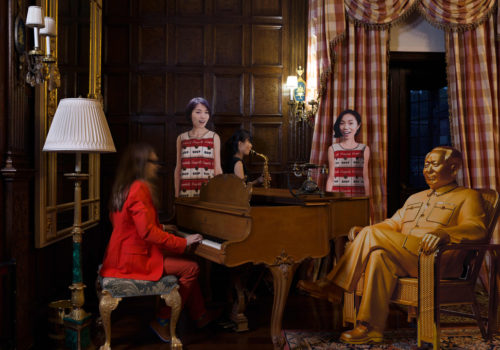One thousand photographs I’ve never been in
Four billion years ago the Sun was shining on the Earth, and the power of the light created a contrast of two binary colors. Nothing predicted appearance of lighting equipment in the studio and skills to work with it. In the twentieth century nothing implied the transition from analogue to digital civilization that required artists from all around the world to change brushes for technology. A camera for a computer. Photography ceased to be inconceivable. The record on the player stopped. Movie camera and camera mirror personifying the living stopped making the popping sound.
The entropy of a closed system increases. Entropy stands for the number of options with which you can build all the entities in the universe without changing the general settings of the system. In other words, it means that proportion of chaos is growing in of all the worlds visible to us. If you, drafting off the scientific constructions, look at the current processes through the physical hypotheses, you will find a surprising analogy: growth of the digital eld volume. Overproduction destroys the Institute of authorship. In art, technology does the same as with the flights to the Moon, where you can’t get on your own, but can easily do with the help of coal, steel and the ideology of the whole state. That’s why the border between canvas and theater, cinema and web camera, web camera and Facebook, is disappearing and billions of images per day pour down on the audience as a sewerage typhoon. A whole city, autonomy, region, even a whole federation goes to the cinema to watch “Avatar.” What of the authorship Institute. It is literally an invasion of galaxies, myriads of clusters, focusing thin thermonuclear beam in the cognitive space of the viewer, lying beyond the bounds of common sense.
Andy Warhol was the first Don Quixote of the digital revolution, a Che Guevara of computer networks, taking their eight-hour movie about a sleeping individual. The master naively believed that he could win Facebook and Instagram with the analog lm grain, to resist the invasion of the exabyte civilization. A romantic scientist, he invented the last antibike antibiotic on the Earth, challenging the robots! In some ways, he succeeded. Fifteen minutes of fame, it looks like an eternity: now during this time you can be born, to be educated, to live slowly and beautifully, and curl up in the grave. What kind of morals!Mao was Andy Warhol’s brother in the strict sense. And he was his antiparticle, his confrontation—in more figurative one. In the artistic aspect, an ideology—is the art antimatter. Money is the newly-born in the twentieth century antimatter of time. Now, if we connect all these terms, it becomes clear why Warhol was cranking out portraits of Mao and other participants of the graceful public scene. It was still local photography, an attempt to equilibrate opposing each other within a large family. In classical physics, this is called Newton’s third law. The heroes were from the same era and imitated each other, distributing combinations of entropy within their characters. Mao wanted his fifteen minutes of fame. Warhol was jealous of authoritarianism. That’s the way the history of revolutions and arts has been made up.
Today Facebook, computer, pixels, likes, tweets and reposts are on the eld of battle. It’s hard to tell if the battle between art and revolution lasts in its pure alike the ones what we see on the wounds of artifacts exhibited at the museums. The individual conflicts with the authorities. Mao declared war against the beautiful Japanese girls for their stubbornness; Japan cannot stand the “Western” context of all possible Warhols and anti-Warhols. As in a good scenario, everyone confronts everyone,suspecting and repelling.The boundaries of co-existence and causes of conflicts still have all the same old human nature layering on the new technologies. The conflict of the romantic duel with swords turns into a struggle of digital streams and computer algorithms that replace a living cell. In this discourse, I’d like to look back. Sit back and relax. Physics says that entropy can be locally reduced. Which means you can look back on a vinyl player, put on a record, dance tango. Sit in the evening with a book. Suppose we exist between the layers of technology, liking in Facebook and posting selfies, but we still wear the old magical pants of virtual reality, embarrassed by the old-fashioned—the analog.
Orange jacket comes to digital photography as a vaccine, as nostalgia for the enlarger and fixer. Orange jacket—is a touch-up in the trillions of frames of identical megapixel cameras, bored of vapid postures. When grandpa Mao makes friends with a lovely Japanese woman sitting in a golden chair somewhere in the Kuril Islands, encouraged by Andy Warhol’s accompaniment, this means that all the characters are a little tired of the ideological rhetoric of the numerous revolutions: bloody, cultural, digital and others. Our heroes from the photographs came together to drink champagne and recall the good past with an old word. Maybe even embrace each other and cry together.
Kuzma Vostrikov, New York, October 9, 2016
















